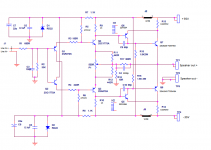Hi all,
I'm wondering, how important is it to match each transistor pair?
I mean, how much HFE difference is accepted between a PNP and NPN pair?
Per amp I have:
Pairs 1 & 2:
2 x Hitachi 2SA872 HFE 525
2 x Hitachi 2SC1775 HFE 615
Pair 3:
1 x NEC 2SA634 HFE 166
1 x NEC 2SC 1096 HFE 157
Pair 4:
1 x Toshiba 2SA1943 HFE 98
1 x Toshiba 2SC5200 HFE 93
Any help is valued.....
Kind Regards,
Sjoerd Smits
I'm wondering, how important is it to match each transistor pair?
I mean, how much HFE difference is accepted between a PNP and NPN pair?
Per amp I have:
Pairs 1 & 2:
2 x Hitachi 2SA872 HFE 525
2 x Hitachi 2SC1775 HFE 615
Pair 3:
1 x NEC 2SA634 HFE 166
1 x NEC 2SC 1096 HFE 157
Pair 4:
1 x Toshiba 2SA1943 HFE 98
1 x Toshiba 2SC5200 HFE 93
Any help is valued.....
Kind Regards,
Sjoerd Smits
For transistors of opposite polarity close Hfe matching often is difficult to obtain.
If you match the hfe within 10% the most is good.
If You in addition match the Vb-e at the same time within 20mV You are even better.
I always match mine within just a couple of millivolts.
As for Hfe matching I am very careful to match transistors in differential configuration.
The numbers You are having there looks fine+
If you match the hfe within 10% the most is good.
If You in addition match the Vb-e at the same time within 20mV You are even better.
I always match mine within just a couple of millivolts.
As for Hfe matching I am very careful to match transistors in differential configuration.
The numbers You are having there looks fine+
Hi,
So these values will do fine? I was thinking the 90 HFE difference would not be ok....
I guess I need to find out how to measure VB-e 🙂 I get the feeling that is more important!
Thanks!
So these values will do fine? I was thinking the 90 HFE difference would not be ok....
I guess I need to find out how to measure VB-e 🙂 I get the feeling that is more important!
Thanks!
Difficult to be absolutely shure without knowing how the amps topology is.
If You could post asome schematics, I could see what You could expect.
If You could post asome schematics, I could see what You could expect.
No.😱
Been out for a while.
The Q2 and Q 4 should be matched, and the Q1 and Q3 should be matched.
When theese are done, the whole input is in balance.
Quite nifty way to obtain it. No need to match between the NPN and PNP.
I would have ensured good thermical contact between Q3, Q4 and the heatsink. Seems as theese are all involved in the bias cirquit for this amp.
The drivers and the output transistors is difficult to get within the same Hfe-range, wich isn't too critical either.
Been out for a while.
The Q2 and Q 4 should be matched, and the Q1 and Q3 should be matched.
When theese are done, the whole input is in balance.
Quite nifty way to obtain it. No need to match between the NPN and PNP.
I would have ensured good thermical contact between Q3, Q4 and the heatsink. Seems as theese are all involved in the bias cirquit for this amp.
The drivers and the output transistors is difficult to get within the same Hfe-range, wich isn't too critical either.
Hi,
Then I'm ok regarding the HFE of my Q1 vs Q3 and Q2 vs Q4.
How do you mean thermal contact? The only ones on heatsinks are Q5 & Q6....
Then I'm ok regarding the HFE of my Q1 vs Q3 and Q2 vs Q4.
How do you mean thermal contact? The only ones on heatsinks are Q5 & Q6....
PS: This is not my design.... It's the Hiraga 30 Watt Class A topoligy whitch was upgraded by "Dan".
See: Jean Hiraga's Super Class-A Amplifier
Seemed like a good ideato build this amp 🙂
See: Jean Hiraga's Super Class-A Amplifier
Seemed like a good ideato build this amp 🙂
Aren't Q5 and Q6 close to the heatsink?
Ofcourse, this is a class A amp. My bad. Says Hiraga further up here too.
The pot is only for the output offset.
No bias setting here.
Go for it.
Just be careful obtaining the voltages shown in Your link. Should be just fine.
Ofcourse, this is a class A amp. My bad. Says Hiraga further up here too.
The pot is only for the output offset.
No bias setting here.
Go for it.
Just be careful obtaining the voltages shown in Your link. Should be just fine.
- Status
- Not open for further replies.
- Home
- Amplifiers
- Solid State
- Matching transistors
